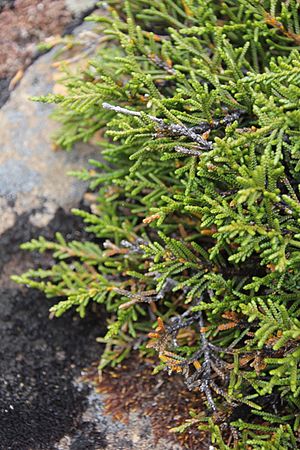Creeping pine facts for kids
Quick facts for kids Creeping pine |
|
|---|---|
 |
|
| Microcachrys tetragona, Illustration. | |
| Scientific classification | |
| Genus: |
Microcachrys
|
| Species: |
tetragona
|
Microcachrys tetragona, also known as the creeping pine or creeping strawberry pine, is a special type of conifer. Conifers are trees or shrubs that usually have needles and cones, like pine trees. This plant belongs to the Podocarpaceae family. It's the only species in its group, called the genus Microcachrys.
This plant is found only in western Tasmania, an island south of Australia. It grows as a low shrub, usually less than 1 meter tall. You can find it in high mountain areas.
Microcachrys tetragona has unique leaves. They look like small scales. These leaves grow in pairs, opposite each other on the stem. This is unusual for plants in the Podocarpaceae family. The leaves look a bit like those of another plant called Diselma archeri. Female plants produce tiny, red berries in the summer. These berries are safe to eat.
Ancient History of the Creeping Pine
Microcachrys is a very old plant. Scientists call it a "relictual plant." This means it was once found in many places but now grows in only a few spots. The only species alive today, Microcachrys tetragona, has very special pollen. This pollen is different from other plants in its family.
Scientists have found fossil pollen from Microcachrys all over the Southern Hemisphere. This includes places like Antarctica, Australia, New Zealand, southern Africa, and South America. These fossils show that Microcachrys used to grow across a huge ancient continent called Gondwana.
Today, Microcachrys tetragona is only a small shrub. It lives in the mountains of Tasmania. The fossil record of Microcachrys helps us understand how plants have changed. It shows how the Southern Hemisphere's plant life has shifted a lot since Gondwana broke apart.
See also
 In Spanish: Microcachrys para niños
In Spanish: Microcachrys para niños


